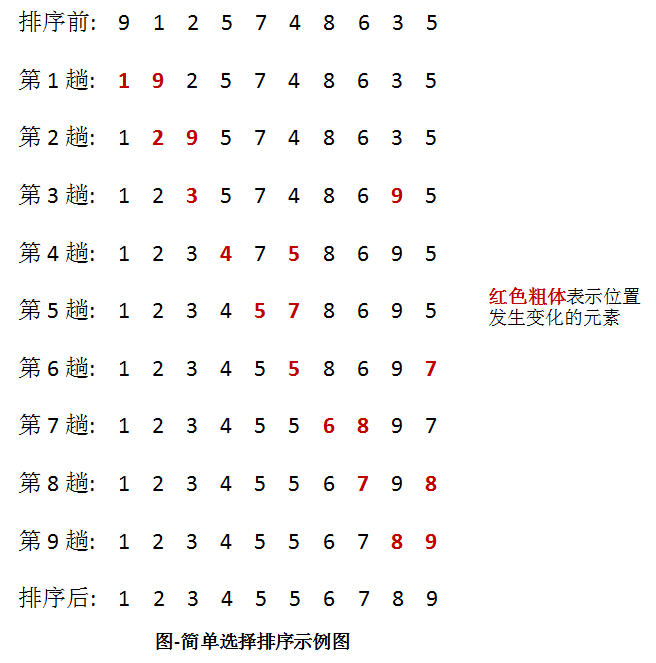前言
选择排序:每趟从待排序的记录中选出关键字最小的记录,顺序放在已排序的记录序列末尾,直到全部排序结束为止。
算法思想
简单选择排序很简单,它的大致处理流程为:
- 从待排序序列中,找到关键字最小的元素;
- 如果最小元素不是待排序序列的第一个元素,将其和第一个元素互换;
- 从余下的 N - 1 个元素中,找出关键字最小的元素,重复(1)、(2)步,直到排序结束。
动态效果示意图:

举例说明,处理过程示意图如下所示:

如图所示,每趟排序中,将当前第 i 小的元素放在位置 i 上。
代码
Python:列表排序
# -*- coding:utf-8 -*-
def SelectSort(input_list):
'''
函数说明:简单选择排序(升序)
Parameters:
input_list - 待排序列表
Returns:
sorted_list - 升序排序好的列表
'''
if len(input_list) == 0:
return []
sorted_list = input_list
length = len(sorted_list)
for i in range(length):
min_index = i
for j in range(i + 1, length):
if sorted_list[min_index] > sorted_list[j]:
min_index = j
if min_index == i:
continue
temp = sorted_list[i]
sorted_list[i] = sorted_list[min_index]
sorted_list[min_index] = temp
# 上面三步交换也可以使用交叉赋值
return sorted_list
if __name__ == '__main__':
input_list = [6, 4, 8, 9, 2, 3, 1]
print('排序前:', input_list)
sorted_list = SelectSort(input_list)
print('排序后:', sorted_list)
C:字符串排序
#include <stdio.h>
#include <stdlib.h>
#include <string.h>
#define MAX 20 // 最大字符串长度
/* ---------------------------------------- */
/* 选择排序法 */
/* ---------------------------------------- */
void select(char *string, int count)
{
int pos; // 目前最小的字符
int i, j;
char temp;
for ( i = 0; i < count - 1; i++ ) // 第一层循环
{
pos = i;
temp = string[pos];
/* 查找最小的字符 */
for ( j = i + 1; j < count; j++ ) // 第二层循环
if ( string[j] < temp ) // 是否更小
{
pos = j; // 新的最小字符
temp = string[j];
}
string[pos] = string[i]; // 交换两字符
string[i] = temp;
printf("输出结果: [%s]
", string); // 输出交换后字符串
}
}
/* ---------------------------------------- */
/* 主程序: 输入字符串后将字符串排序 */
/* ---------------------------------------- */
int main(void)
{
char string[MAX]; // 字符串数组
int count; // 字符串长度
printf("输入要排序的字符串 ==> ");
gets(string); // 读取字符串
count = strlen(string); // 计算字符串长度
select(string, count); // 选择排序法
printf("
输出排序结果: [%s]
",string); // 输出排序后字符串
}
算法分析
简单算法排序性能

时间复杂度
简单选择排序的比较次数与序列的初始排序无关。假设待排序的序列有 N 个元素,则比较次数总是 N (N-1)/ 2。
而移动次数与序列的初始排序有关。当序列正序时,移动次数最少,为 0 。
当序列反序时,移动次数最多,为 3N (N - 1) / 2。
所以,综合以上,简单排序的时间复杂度为 O(N2)。
空间复杂度
简单选择排序需要占用 1 个临时空间,用于保存最小值得索引。
本站整理自: